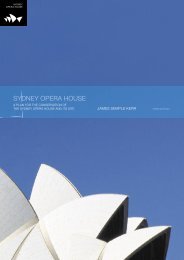nomination by the Government of Australia - Sydney Opera House
nomination by the Government of Australia - Sydney Opera House
nomination by the Government of Australia - Sydney Opera House
Create successful ePaper yourself
Turn your PDF publications into a flip-book with our unique Google optimized e-Paper software.
3.17 3.18<br />
Utzon’s genius is manifested in <strong>the</strong> many outstanding<br />
elements <strong>of</strong> <strong>the</strong> <strong>Sydney</strong> <strong>Opera</strong> <strong>House</strong>. The podium<br />
and shells exemplify his masterful syn<strong>the</strong>sis <strong>of</strong> <strong>the</strong><br />
different architectural styles and aes<strong>the</strong>tics: <strong>the</strong> simple<br />
and gigantic geometric shapes <strong>of</strong> <strong>the</strong> shell structure<br />
which are emphatically modern but also have an<br />
organic origin; and <strong>the</strong> external cladding <strong>of</strong> ceramic<br />
tiles inspired <strong>by</strong> ancient buildings and <strong>the</strong> art <strong>of</strong><br />
contemporary Asian ceramics. These are described in<br />
detail in <strong>the</strong> following sections.<br />
The result is stunning, one <strong>of</strong> <strong>the</strong> most radiant<br />
and alive surfaces in architecture, thoroughly<br />
modern in its abstraction and technically<br />
impossible before its day—au<strong>the</strong>ntic Our Time<br />
Style—yet utterly timeless. As passing clouds,<br />
<strong>the</strong> sun or viewer move <strong>by</strong>, <strong>the</strong> shells glow,<br />
gleam or fl ash with light. Stand closer and<br />
incline your head to left or right—Cezanne’s<br />
approach to his motif and Monet’s ‘Series’<br />
paintings inevitably come to mind—and waves<br />
<strong>of</strong> tiles scintillate like diamonds or tiny stars.<br />
Devoid <strong>of</strong> colour, yet uniquely receptive to <strong>the</strong><br />
colours <strong>of</strong> light and <strong>the</strong> surroundings, <strong>the</strong> shells<br />
present an ever-changing spectacle (Weston<br />
2004a: 156).<br />
Amongst Utzon’s most remarkable achievements<br />
was his creation <strong>of</strong> a magnifi cent sculptural form that<br />
simultaneously conveys a sense <strong>of</strong> having emerged<br />
organically from <strong>the</strong> natural landscape. The building<br />
exudes a special presence: it appears to <strong>the</strong> viewer to<br />
be absolutely an ‘obvious, immediate and evident’ part<br />
<strong>of</strong> <strong>the</strong> landscape and ‘as though only his typical “shells”<br />
could occupy Bennelong Point’ (Moneo 2004: 88).<br />
Figure 3.16 The matt and glossy ro<strong>of</strong> tiles took three years<br />
to develop with <strong>the</strong> manufacturer. The textured surface<br />
<strong>of</strong> <strong>the</strong> glossy tiles creates a surface that responds to <strong>the</strong><br />
changing light.<br />
3.A (ii) Outstanding achievements in structural<br />
engineering and technological innovation<br />
The <strong>Sydney</strong> <strong>Opera</strong> <strong>House</strong> is not <strong>the</strong> kind <strong>of</strong><br />
building which <strong>of</strong>ten comes within <strong>the</strong> orbit<br />
<strong>of</strong> <strong>the</strong> structural engineer. It is an adventure<br />
in building ... Because <strong>the</strong> circumstances<br />
under which it is being built are so unusual,<br />
and because its problems are so diffi cult, it<br />
has created unique opportunities, both in <strong>the</strong><br />
design <strong>of</strong>fi ce and on <strong>the</strong> site … The structure<br />
now standing in <strong>Sydney</strong> Harbour is <strong>the</strong> result<br />
not only <strong>of</strong> much toil and sweat but also <strong>of</strong><br />
an unprecedented collaboration between<br />
architect, engineer and contractor ... we<br />
stretched ourselves to <strong>the</strong> limits <strong>of</strong> our skills<br />
(Arup & Zunz 1988: 3–5).<br />
The <strong>Sydney</strong> <strong>Opera</strong> <strong>House</strong> is <strong>of</strong> outstanding<br />
universal value for its engineering and technological<br />
achievements and o<strong>the</strong>r innovations. Its value derives<br />
in part from Utzon’s unique design and his distinctive<br />
approach which included <strong>the</strong> integration <strong>of</strong> design,<br />
engineering and construction (see above and Part<br />
2.B). A vibrant and creative interaction emerged<br />
between architects, industrial designers, engineers,<br />
manufacturers and <strong>the</strong> construction industry—all<br />
striving to meet <strong>the</strong> challenges <strong>of</strong> his unprecedented<br />
design concept as well as <strong>the</strong> constantly evolving<br />
designs and exacting requirements during <strong>the</strong><br />
construction <strong>of</strong> <strong>the</strong> building. His radical approach<br />
demanded <strong>the</strong> development <strong>of</strong> innovative new<br />
techniques and materials and anticipated <strong>the</strong> methods<br />
<strong>of</strong> eminent late 20th century architects Norman Foster<br />
and Renzo Piano (Weston 2002: 180).<br />
Figure 3.17 The ‘spine’ between <strong>the</strong> vaulted ro<strong>of</strong> shells<br />
constructed <strong>of</strong> prefabricated ribs<br />
Figure 3.18 Drawing <strong>of</strong> <strong>the</strong> prefabricated ribs and tile lids<br />
from <strong>the</strong> Yellow Book 1962<br />
35

















